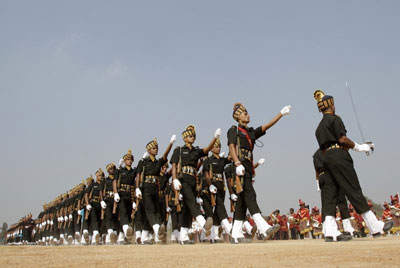Sunday Times 2
Diplomatic coup: Obama at India’s Republic Day parade
The news was launched on Twitter: Prime Minister Modi, well known as one of the most prolific tweeters among today’s heads of government, had invited President Barack Obama to attend India’s Republic Day parade on January 26 as the chief guest. Within half an hour, the White House had announced (and tweeted) back: Obama was delighted to accept.
This is a huge deal. Obama will be part of what may be the most theatrical parade in the world. The Chief Guest slot is by far the most prestigious invitation India can extend to a foreign leader. Japanese Prime Minister Abe was last year’s honouree. Obama is the first U.S. president to be honoured in this way, and the first to visit India twice during his time in office.

File pic: Indian soldiers march during the Republic Day parade in the southern Indian city of Hyderabad January 26, 2013.Reuters
What does this mean? The Times of India called the invitation a “diplomatic coup” for Modi. What a change. Less than a year ago, Modi was close to being a pariah in official Washington. But it is in a sense a coup for both leaders. At a personal level, the challenges of political Washington will make it doubly welcome to Obama. By the end of January, the Republican-led Congress will be settling in in Washington. Other presidents under pressure have found relief in international travel; the same could be true of this one.
This event is also an opportunity. The two governments have more on their “to do” lists than they have staff to do it. They will now have the chance – and the need – to devote substantial time to their important relationship between now and the end of January. The U.S.-India dispute over trade facilitation and agricultural subsidies in the World Trade Organisation had left serious bruises in Washington. The resolution announced earlier last month, following an Obama-Modi meeting in Myanmar, removes one of the clouds that might have hung over the Obama visit.
The action items coming out of Modi’s visit to Washington offer a good starting point for the next installment of bilateral accomplishments. The list includes India’s “smart cities” initiative and U.S. participation in it; nuclear liability and U.S. hopes for nuclear exports to India; renewal of the U.S.-India defence cooperation agreement; and India’s hopes for joining the world’s export control “clubs.” The two countries could also work on more ambitious goals. Two that would be especially sweet are climate change and expanding trade. The U.S.-China climate agreement announced earlier this month suggests a pattern India could look at and perhaps modify. And with India now engaged in free trade agreements with ASEAN, Korea, and Japan, could we start thinking about what it would take to conclude an agreement with the United States?
But this exciting opportunity does not mean that India and the United States have now resolved all their troublesome issues. Their relationship is built on common interests, especially those touching security and prosperity in Asia. But the two countries have been bedeviled in the past by differences in both style and substance. India’s concept of “strategic autonomy” still fits uncomfortably with the U.S. concept of itself as a global leader. The two countries have different objectives for international trade, and different notions of partnership.
The good news is that the symbolism of this invitation can help produce substantive results that benefit both countries. New Delhi and Washington have a high maintenance relationship, which requires substantial doses of high level respect and attention to move forward. Republic Day comes only four months after Modi’s epic visit to Washington. The attention is there. Now is a good time to do something with it!
(Teresita Schaffer served as a US ambassador in Sri Lanka from Oct 1992 to Aug1995)
Courtesy South Asia Hand

